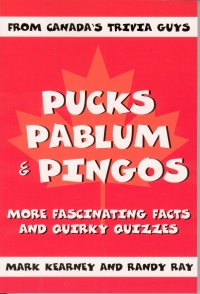| ________________
CM . . .
. Volume XI Number 3 . . . . October 1, 2004
excerpt:
How much does the average Canadian know about his or her country? Not nearly enough, according to Mark Kearney and Randy Ray, authors of Pucks, Pablum & Pingos. Following the blueprint they established in six previous books of trivia, the two long-time journalists return to shore up the collective Canadian consciousness with "more fascinating facts and quirky quizzes." A domestic readership (the intended audience) will be surprised and proud to learn of important Canadian contributions on a vast number of fronts. The introduction's disclaimer that "this book has something of a random feel to it" (p. 9) hits the nail on the head: the information is not forced to a tongue-and-groove fit. Though the authors subdivide their book into seven sections that cover history, arts and culture, commerce, famous Canadians, geography, politics, and sports, they allocate not just the usual one section but two sections to miscellany. "Odds and Sods" appears in the middle whereas "Trivia Treasure Trove" caps off the end. These sections compress various and sundry bits (name changes, obesity, potholes, food and beverage consumption, and statistical averages) into trivia chipboard. One has a strong hunch that Pucks, Pablum & Pingos could have been hastily hammered together because it contains a lot of material salvaged from the authors' past research. Yet, if its substance is familiar, the book's structure is a marked improvement over that of its predecessors. For instance, Pucks, Pablum & Pingos replaces the question-and-answer format of The Great Canadian Trivia Book and The Great Canadian Trivia Book 2 with a sleeker design that demarcates entries proper with round bullets. Roughly 550 entries of 20 to 75 words apiece lay down a sizeable foundation of Canadian trivia in manageable text blocks. Adding to the visual interest of the layout are headings, sidebars, captioned black and white photographs, and "timelines." Headings provide the decorative trim to complement the functional serifed font. In contrast, sidebars with faint drop shadows act like recesses in walls to draw attention to the origin of the Hockey Night in Canada theme, for example, or to the Prime Minister who served the shortest term. The photographic reproductions, on the other hand, many of them of National Archives holdings or of Canada Post commemorative stamps, frequently serve as windows on the past. The photographs are small in size, yet discernible; they appear in generous quantity throughout. Finally, "timelines" are two-column outlines of eventful dates in Canada's history. In a strange twist, the combination of month and day carries more weight than the year in organizing the material: the left-hand column proceeds chronologically on the basis of month and day, while the right-hand column identifies the year and details of the incident. In most cases, the timeline is the next-to-last feature of a chapter, with quiz answers installed immediately after it. The most noteworthy of recurring features in the Pucks, Pablum & Pingos architecture is that of the quiz. Kearney and Ray devise a total of twenty challenging quizzes for readers. There is at least one quiz per chapter, and up to as many as four! Readers must know their Canadian trivia inside-out and backwards in order to obtain full marks. Quiz questions range in scope, from asking what type of Canadian police badge Paul McCartney wore on the cover of the Sgt. Pepper's Lonely Hearts Club Band album (p. 55) to asking which two provinces first made seatbelt use mandatory (p. 32). If there is a criticism to be leveled at this book, it is that Pucks, Pablum & Pingos requires a touch more attention to details. For instance, on p. 136 the first entry should begin with a bullet; instead, the symbol is a lowercase superscript "a." Second, p. 129 refers to "Nigerville, Manitoba," which should to all accounts and purposes read "Niverville." Third, even if the book aims to represent all of Canada, the level still tilts more favorably towards the East. The index, too, would benefit as a result of some additional repair work. Here the index is systematically alphabetized, but it lacks the breadth one might expect. Proper nouns, mostly, furnish it. Then, too, although "Winnipeg Blue Bombers" and "Winnipeg General Strike" are indexed, there is no entry for "Winnipeg," even despite mention of the city in conjunction with the first recorded Canadian auto accident (p. 108) and as the home of John Hopps, inventor of the pacemaker (p. 102). (No entry for "Hopps" exists in the index, either.) Nevertheless, Pucks, Pablum & Pingos is worth adding to collections of Canadian trivia. It will appeal to a wide age bracket. Essentially, the words of the CM reviewer of The Great Canadian Trivia Book 2 apply to Pucks, Pablum & Pingos also: "Great for cottages, bathrooms, and kids with short attention spans!" Add to that the fact that the trivia can be used to initiate coffee break conversations, to entice students into Canadian Studies, and to prepare for Trivial Pursuit, Canadian Edition showdowns - what more could one want? Once again, Kearney and Ray effectively deconstruct the myth that Canada is "without form and void." The nation they present is no shabby shanty, no British or American lean-to, but a grand edifice still under construction. Recommended. Julie Chychota continues to grow in a mixture of Winnipeg sun and shade.
To comment
on this title or this review, send mail to cm@umanitoba.ca.
Copyright © the Manitoba Library Association. Reproduction for personal
use is permitted only if this copyright notice is maintained. Any
other reproduction is prohibited without permission.
NEXT REVIEW |
TABLE OF CONTENTS FOR THIS ISSUE
- October 1, 2004.
AUTHORS |
TITLES |
MEDIA REVIEWS |
PROFILES |
BACK ISSUES |
SEARCH |
CMARCHIVE |
HOME |
